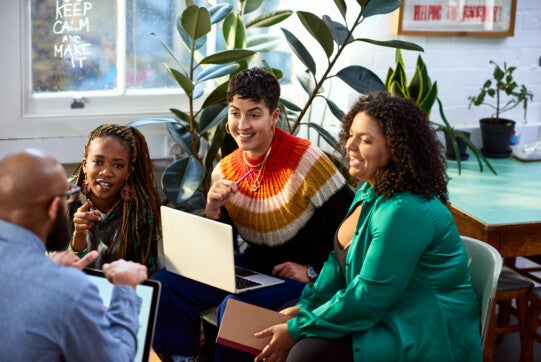Identifying Empathy Gaps: Practical Strategies for Grantmaking Leaders

I recently had the honor of presenting at bbcon 2025 in amazing Philadelphia. Not only did I attend thought-provoking sessions and connect with lovely social impact soulmates, I also had fun exploring the rich history and culture of Philadelphia.
One of the highlights was taking a tour of the city with an amazing guide, who, it turned out, not only was a Philly native, but also had a PhD in History. As I talked about my experience at the Museum of the American Revolution, he shared how it is one of his favorites because he said, “the museum leaves you understanding that it’s complicated.” He said that as a historian it is frustrating to leave a museum that shares a narrative that history is clean, straightforward, or simple.
This sentiment of the importance and essential nature of complexity is perfectly connected to my session and the work that we all do in the sector. My conference session, “The Empathy Opportunity: How Our Collective Unknowns Can Fuel Our Collaborative Impact,” focused on why efforts in social impact often fall short due to a lack of understanding of ourselves and the people we aim to support, operating from untested assumptions rather than genuine connection.
I focus on empathy gaps because when unidentified and ignored, these gaps can grow to become significant chasms. Empathy gaps are those challenging situations where individuals or groups struggle immensely to understand or genuinely relate to the feelings, thoughts, and lived experiences of others. These gaps can manifest in myriad ways, consistently leading to frustration, miscommunication, escalating conflict, and, perhaps most painfully, missed opportunities for profound connection and collaborative problem-solving.
Identifying Empathy Gaps in Our Work
After I introduced the definition of empathy and power, and we discussed the roles of positionality and bias, I invited session attendees to explore how their personal and professional biases create empathy gaps. I shared examples of when I had crafted narratives for others based on my own interpretations, biased views, and limited lived experiences. I shared how team members I’ve had the honor to support had moved through misinterpretation, disconnection, and frustration to better understand the needs of their colleagues and communities.
To get specific and practical, I asked each attendee to identify an empathy gap in the sector before identifying empathy gaps in their daily work. I shared the following examples to get folks started. Someone who works at a philanthropic foundation might say, “I wish that nonprofit organizations would better understand that we receive more than 200 unsolicited proposals requesting funding every month. This feels overwhelming and we don’t have the staff or financial capacity to support all the growing needs.” Someone who works at a nonprofit organization might say, “I wish that foundations would better understand that we spend numerous hours writing grant proposals only to then, months later, receive a generic email rejection with zero feedback.”
On sticky notes, attendees, who included representatives from nonprofit, philanthropy, and consulting organizations, completed this statement. “I wish that _______________ would better understand that _______________ (something that frustrates you, makes you feel misunderstood).”
Naming Our Empathy Gaps
What attendees generously shared (with full consent to appear in this article) fell into a few themes. Can you relate?
Attendees wished that leadership, their boards, and administration would acknowledge their experience and understanding of what works, the time investment required for meaningful donor relationships, the non-linear nature of fundraising, and the extensive effort involved in organizing fundraising events.
- “I wish that leadership would know that our team knows what will and will not work based on our experience.”
- “I wish that leadership/board understood that fundraising is not linear, nor exponential, nor infinite.”
- “I wish our executive leadership team recognized philanthropy as a positive value and ROI generator for the business.”
- “I wish that our internal decision makers better understood the level of work behind grant prep.”
They shared empathy gaps between funders and nonprofit organizations, feeling like those who award funding need a better understanding of nonprofit realities, including recognizing that success isn’t always about improvement measurements (sometimes maintaining the status quo is sufficient), that large nonprofits still require significant operating funds, and that more general operating funding is crucial for sustainability.
In addition, attendees felt that donors need a better understanding of several key areas: the importance of supporting long-term recovery efforts, that nonprofits share the same goal as donors of making their communities better, and the value of investing in “overhead” (systems, data, people, and processes) for organizational efficiency.
- “I wish that foundation directors would better understand knowledge building is action and not a useless activity or less valuable than dollars.”
- “I wish donors would better understand that gifts fund human outcomes, not just equipment or buildings.”
Those attendees representing grantmakers expressed empathy gaps with their nonprofit partners.
- “I wish that applicants better understood the amount of time required to effectively evaluate their grant proposals.”
- “I wish that our grant requestors better understood the importance of thorough grant requests, and the impact that they can make on final decisions.”
The process of naming our empathy gaps, often with frustration signaling an “empathy opportunity,” is part of identifying what we need to better understand about each other’s perspectives, work, needs, values, and visions for social change. The key to bridging these gaps is cultivating curiosity, pausing to listen, and committing to learning.
Start with Self-Inquiry to Foster Understanding
Self-inquiry is where this work begins. Ask questions about what you genuinely don’t understand, name and challenge your ingrained assumptions, potential biases, and acknowledge what you need to learn. Turn your unknowns into curious questions and engage in curious conversations to foster understanding, build trust, and achieve greater, more sustainable impact in the social sector.
Feeling stuck in your status quo, even though you know you have empathy gaps you need to address? Check out the webinar, Why We Get Stuck and How to Get Unstuck, where Heather Hiscox discusses the four key factors that hold teams back from addressing challenges.



